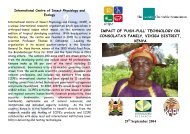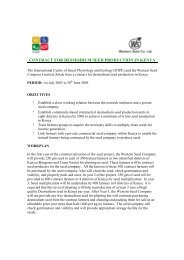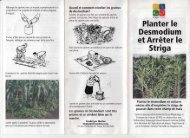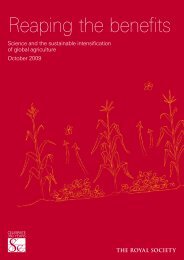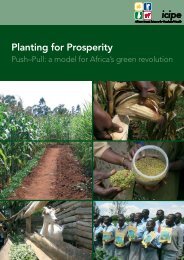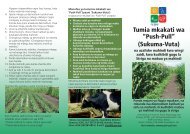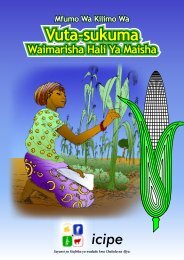Biology and management of economically important ... - Push-Pull
Biology and management of economically important ... - Push-Pull
Biology and management of economically important ... - Push-Pull
Create successful ePaper yourself
Turn your PDF publications into a flip-book with our unique Google optimized e-Paper software.
718 KFIR ET AL.<br />
was shown. As there is not yet any evidence that the C. flavipes density has reached<br />
an equilibrium, it may continue to increase <strong>and</strong> provide greater suppression <strong>of</strong> stem<br />
borers in the future.<br />
In addition to the work conducted in Kenya, a survey in 1995 in northern <strong>and</strong><br />
central Tanzania recovered C. flavipes at two locations near Lake Victoria in an area<br />
bordering southwestern Kenya (140). Based on surveys conducted prior to 1994,<br />
<strong>and</strong> on electrophoretic evidence, it was concluded that the most likely explanation<br />
was that C. flavipes moved into Tanzania from Kenya (140).<br />
Releases <strong>of</strong> C. flavipes were made in Mozambique in 1996 (50) <strong>and</strong> in Ug<strong>and</strong>a<br />
<strong>and</strong> Somalia in 1997 (141). Recoveries in Mozambique in 1999 indicated that the<br />
parasitoid had established but parasitism was low. In Ug<strong>and</strong>a, one year after the<br />
release <strong>of</strong> C. flavipes, it had become the most common parasitoid <strong>of</strong> a complex<br />
<strong>of</strong> four stem borers, <strong>and</strong> parasitism averaged about 20% (107). No postrelease<br />
surveys have been conducted in Somalia, but recoveries in neighboring Ethiopia,<br />
where the parasitoid was never released (W.A. Overholt, unpublished information),<br />
strongly suggest that the parasitoid established in Somalia <strong>and</strong> moved into Ethiopia.<br />
Releases in Zimbabwe, Zambia, Zanzibar, <strong>and</strong> Malawi were made in 1998–1999,<br />
but to date, establishment has not been confirmed (W.A. Overholt, unpublished<br />
information).<br />
Examination <strong>of</strong> the failures <strong>and</strong> successes in establishing exotic parasitoids<br />
suggests several factors that may be related to establishment. The success rate on<br />
the Indian Ocean Isl<strong>and</strong>s has clearly been much higher than on mainl<strong>and</strong> Africa,<br />
where the only confirmed establishment has been C. flavipes. The higher rate <strong>of</strong><br />
establishment on isl<strong>and</strong>s is true not only for stem borer parasitoids but for natural<br />
enemies introduced against other pests as well. Greathead (65) reviewed classical<br />
biological control in Africa <strong>and</strong> suggested that the greater success on the Indian<br />
Ocean Isl<strong>and</strong>s could be explained by the theory <strong>of</strong> isl<strong>and</strong> biogeography (104).<br />
Species are packed more tightly <strong>and</strong> are more specialized on continents than on<br />
isl<strong>and</strong>s, <strong>and</strong> thus, specialist parasitoids encounter less resistance (competition)<br />
when colonizing isl<strong>and</strong>s.<br />
The geographic factor <strong>of</strong> isl<strong>and</strong>s versus the mainl<strong>and</strong> is confounded with a second,<br />
potentially influential factor. The major emphasis <strong>of</strong> the stem borer biological<br />
control activities on the Indian Ocean Isl<strong>and</strong>s was against C. sacchariphagus in<br />
a sugarcane ecosystem, whereas in mainl<strong>and</strong> Africa the work has been directed<br />
mostly in maize <strong>and</strong> sugarcane, with lesser effort in rice. The only successes<br />
in maize have been the introductions <strong>of</strong> Pediobius furvus <strong>and</strong> C. sesamiae from<br />
mainl<strong>and</strong> Africa to Indian Ocean Isl<strong>and</strong>s for control <strong>of</strong> S. calamistis <strong>and</strong> the recent<br />
establishment <strong>of</strong> C. flavipes in Kenya.<br />
Ecological differences between sugarcane <strong>and</strong> maize ecosystems may influence<br />
establishment. Sugarcane is grown throughout the year <strong>and</strong> thus provides a fairly<br />
stable habitat. In contrast, the maize ecosystem is short-lived, providing a suitable<br />
habitat for stem borers <strong>and</strong> their natural enemies for only two or three months.<br />
Brenière et al. (39) suggested that a lack <strong>of</strong> habitat stability on the isl<strong>and</strong> <strong>of</strong> Ngazidja<br />
(Comores) was the reason for several failures <strong>of</strong> the establish parasitoids against





